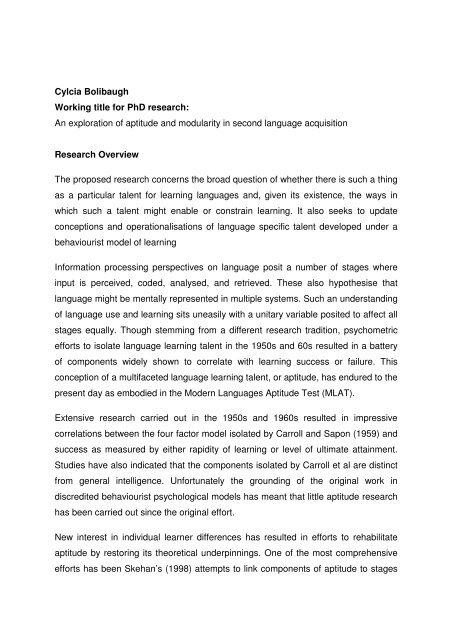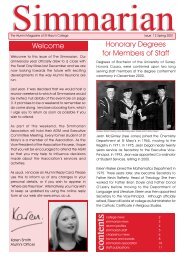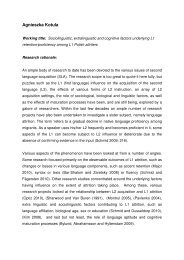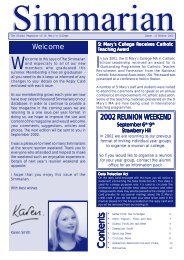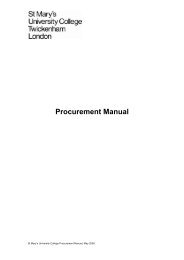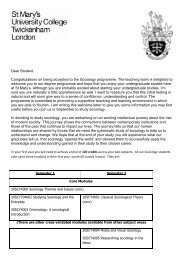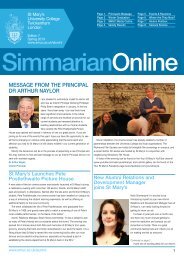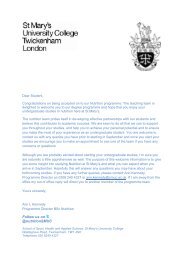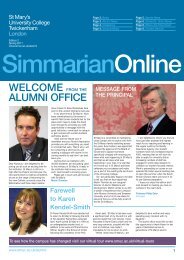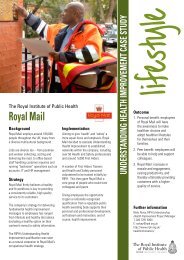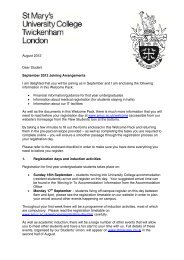An exploration of aptitude and modularity in second language ...
An exploration of aptitude and modularity in second language ...
An exploration of aptitude and modularity in second language ...
Create successful ePaper yourself
Turn your PDF publications into a flip-book with our unique Google optimized e-Paper software.
Cylcia Bolibaugh<br />
Work<strong>in</strong>g title for PhD research:<br />
<strong>An</strong> <strong>exploration</strong> <strong>of</strong> <strong>aptitude</strong> <strong>and</strong> <strong>modularity</strong> <strong>in</strong> <strong>second</strong> <strong>language</strong> acquisition<br />
Research Overview<br />
The proposed research concerns the broad question <strong>of</strong> whether there is such a th<strong>in</strong>g<br />
as a particular talent for learn<strong>in</strong>g <strong>language</strong>s <strong>and</strong>, given its existence, the ways <strong>in</strong><br />
which such a talent might enable or constra<strong>in</strong> learn<strong>in</strong>g. It also seeks to update<br />
conceptions <strong>and</strong> operationalisations <strong>of</strong> <strong>language</strong> specific talent developed under a<br />
behaviourist model <strong>of</strong> learn<strong>in</strong>g<br />
Information process<strong>in</strong>g perspectives on <strong>language</strong> posit a number <strong>of</strong> stages where<br />
<strong>in</strong>put is perceived, coded, analysed, <strong>and</strong> retrieved. These also hypothesise that<br />
<strong>language</strong> might be mentally represented <strong>in</strong> multiple systems. Such an underst<strong>and</strong><strong>in</strong>g<br />
<strong>of</strong> <strong>language</strong> use <strong>and</strong> learn<strong>in</strong>g sits uneasily with a unitary variable posited to affect all<br />
stages equally. Though stemm<strong>in</strong>g from a different research tradition, psychometric<br />
efforts to isolate <strong>language</strong> learn<strong>in</strong>g talent <strong>in</strong> the 1950s <strong>and</strong> 60s resulted <strong>in</strong> a battery<br />
<strong>of</strong> components widely shown to correlate with learn<strong>in</strong>g success or failure. This<br />
conception <strong>of</strong> a multifaceted <strong>language</strong> learn<strong>in</strong>g talent, or <strong>aptitude</strong>, has endured to the<br />
present day as embodied <strong>in</strong> the Modern Languages Aptitude Test (MLAT).<br />
Extensive research carried out <strong>in</strong> the 1950s <strong>and</strong> 1960s resulted <strong>in</strong> impressive<br />
correlations between the four factor model isolated by Carroll <strong>and</strong> Sapon (1959) <strong>and</strong><br />
success as measured by either rapidity <strong>of</strong> learn<strong>in</strong>g or level <strong>of</strong> ultimate atta<strong>in</strong>ment.<br />
Studies have also <strong>in</strong>dicated that the components isolated by Carroll et al are dist<strong>in</strong>ct<br />
from general <strong>in</strong>telligence. Unfortunately the ground<strong>in</strong>g <strong>of</strong> the orig<strong>in</strong>al work <strong>in</strong><br />
discredited behaviourist psychological models has meant that little <strong>aptitude</strong> research<br />
has been carried out s<strong>in</strong>ce the orig<strong>in</strong>al effort.<br />
New <strong>in</strong>terest <strong>in</strong> <strong>in</strong>dividual learner differences has resulted <strong>in</strong> efforts to rehabilitate<br />
<strong>aptitude</strong> by restor<strong>in</strong>g its theoretical underp<strong>in</strong>n<strong>in</strong>gs. One <strong>of</strong> the most comprehensive<br />
efforts has been Skehan’s (1998) attempts to l<strong>in</strong>k components <strong>of</strong> <strong>aptitude</strong> to stages
<strong>of</strong> <strong>language</strong> acquisition. This work was largely based on case studies <strong>of</strong> learners<br />
deemed exceptional; <strong>in</strong> other words those whose success or failure could be shown<br />
to lie outside a normal distribution. From a survey <strong>of</strong> such cases, Skehan developed<br />
a model <strong>in</strong> which particular stages are mediated by <strong>in</strong>dividual components <strong>of</strong> the<br />
<strong>aptitude</strong> complex. While explicitly speculative, the model l<strong>in</strong>ked the stages <strong>of</strong> <strong>in</strong>put,<br />
process<strong>in</strong>g <strong>and</strong> retrieval to the <strong>aptitude</strong> components <strong>of</strong> phonetic cod<strong>in</strong>g ability,<br />
<strong>language</strong> analytic ability <strong>and</strong> memory.<br />
One means <strong>of</strong> test<strong>in</strong>g this model would be to move away from cases <strong>of</strong> exceptional<br />
learners <strong>and</strong> <strong>in</strong>stead chart the aptitud<strong>in</strong>al pr<strong>of</strong>iles <strong>of</strong> those fall<strong>in</strong>g at either end <strong>of</strong> a<br />
normal distribution, i.e. learners who might be deemed, given a certa<strong>in</strong> set <strong>of</strong><br />
circumstances, to be either ‘normally’ poor or talented. This research proposes to<br />
cont<strong>in</strong>ue the work <strong>of</strong> a pilot study conducted by the author at MA level which<br />
<strong>in</strong>vestigated normal learners who had reached levels deemed far above or below<br />
what could normally be expected given sufficient time <strong>and</strong> motivation.<br />
Though based on a very small sample, the aforementioned study suggested that<br />
learners who had spent at least two years attempt<strong>in</strong>g to learn a <strong>language</strong> as an adult<br />
with little result had lower levels <strong>of</strong> phonetic cod<strong>in</strong>g ability than successful learners<br />
(who had either learnt at least two <strong>language</strong>s to a high operational level, or learnt<br />
only one but with<strong>in</strong> a very short time), while these same successful learners<br />
displayed elevated memory abilities when operationalised as work<strong>in</strong>g rather than<br />
rote memory. Thus the so-called ‘peripheral’ components <strong>of</strong> <strong>aptitude</strong> seemed to be<br />
the most likely explanatory variables <strong>of</strong> variability <strong>in</strong> ultimate atta<strong>in</strong>ment.<br />
The proposed research can therefore be considered under two head<strong>in</strong>gs. The first<br />
would seek to replicate the aforementioned study but on a larger scale <strong>and</strong> with<br />
modifications suggested by the results <strong>of</strong> the orig<strong>in</strong>al. Thus by chart<strong>in</strong>g aptitud<strong>in</strong>al<br />
pr<strong>of</strong>iles <strong>of</strong> learners identified as hav<strong>in</strong>g made ga<strong>in</strong>s far above or below what could be<br />
expected, it would seek to confirm the mediat<strong>in</strong>g role <strong>of</strong> various components <strong>of</strong> the<br />
<strong>aptitude</strong> complex at differ<strong>in</strong>g stages <strong>of</strong> acquisition. More specifically these l<strong>in</strong>k <strong>in</strong>put<br />
with phonetic cod<strong>in</strong>g ability, process<strong>in</strong>g with <strong>language</strong> analytic ability, <strong>and</strong> memory<br />
with the output stage. With<strong>in</strong> such a study, the role <strong>of</strong> memory would receive<br />
particular attention as it has been implicated <strong>in</strong> <strong>in</strong>itial cod<strong>in</strong>g as well as retrieval.
The <strong>second</strong> part <strong>of</strong> the research actually precedes the first <strong>and</strong> concerns the<br />
operationalisation <strong>of</strong> the <strong>in</strong>dividual aptitud<strong>in</strong>al components. Advances <strong>in</strong> cognitive<br />
psychology have cast doubts on some <strong>of</strong> the orig<strong>in</strong>al constructs while suggest<strong>in</strong>g<br />
alternatives. One example is the relative downplay<strong>in</strong>g <strong>of</strong> the importance <strong>of</strong> rote<br />
memory <strong>in</strong> favour <strong>of</strong> a more nuanced model. Recent <strong>in</strong>terest <strong>in</strong> work<strong>in</strong>g memory<br />
measures from applied l<strong>in</strong>guists has resulted <strong>in</strong> suggestions that these be added to<br />
any <strong>aptitude</strong> battery. Similar questions have been raised regard<strong>in</strong>g the<br />
operationalisation <strong>of</strong> phonetic cod<strong>in</strong>g ability as a sound to orthography pair<strong>in</strong>g <strong>and</strong> it<br />
has been suggested that non-word repetition may be a better test <strong>of</strong> the construct.<br />
The <strong>in</strong>itial part <strong>of</strong> the research would therefore seek to update operationalisations <strong>of</strong><br />
the memory <strong>and</strong> phonetic cod<strong>in</strong>g ability components <strong>of</strong> the <strong>aptitude</strong> complex<br />
embodied <strong>in</strong> the MLAT.<br />
Research Questions:<br />
• (Part II) Aptitude <strong>and</strong> pr<strong>of</strong>iciency:<br />
Are the cognitive pr<strong>of</strong>iles (as measured by orig<strong>in</strong>al <strong>and</strong> modified subtests <strong>of</strong><br />
the MLAT as well as work<strong>in</strong>g memory tests) <strong>of</strong> so-called normally poor or<br />
talented learners qualitatively similar to pr<strong>of</strong>iles <strong>of</strong> so-called exceptional<br />
learners? It is predicted that results obta<strong>in</strong>ed <strong>in</strong> the pilot study mentioned<br />
above will be replicated, specifically:<br />
o good learners are expected to achieve PCA levels above 80% with<br />
poor learners com<strong>in</strong>g <strong>in</strong> below 60%<br />
o <strong>language</strong> analytic ability is not expected to demonstrate any systematic<br />
relationship with good or poor learners<br />
o rote memory ability is not expected to demonstrate any systematic<br />
relationship with good or poor learners<br />
o good learners are expected to demonstrate a significantly greater<br />
work<strong>in</strong>g memory capacity than poor learners


